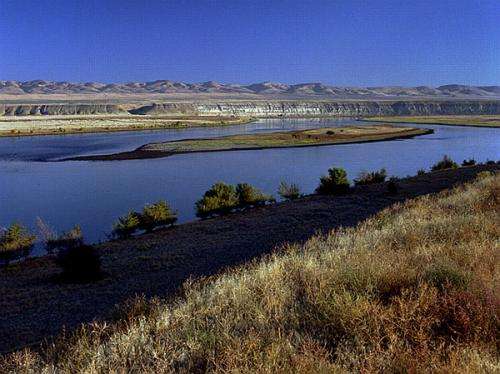Nuclear waste desorption study reveals uranium release slows over time

Scientists at Pacific Northwest National Laboratory investigating fundamental processes and parameters controlling the long-term release of uranium from contaminated sediments observed that uranium release slows dramatically with time and increasing mass loss. This phenomena results from the rapid cleansing of exposed reactive surfaces and the slow diffusion of reacted uranium from intragrain domains of increasing inaccessibility. The findings will enable scientists to construct more accurate models for predicting the dispersal rates of and risks posed by long-present groundwater plumes at the Hanford Site (where plutonium was produced as part of the Manhattan Project) and other sites worldwide.
Uranium poses a serious risk of groundwater contamination wherever present as a subsurface contaminant or a natural geochemical component. Most previous experimental studies addressing uranium release rates from sediment have focused on the small fraction of uranium that is quickly released from solids to groundwater. This study combines modeling and laboratory experiments to assess uranium release under flow conditions where solubilized uranium was removed from the system. Long time periods, lasting more than four months, were employed to assess the kinetic behavior of all uranium present in the sediment samples.
The research team conducted a long-term study of uranium desorption-the release of uranium from sediments to groundwater-under flow conditions using sediments collected from the Hanford Site in southeastern Washington State. The sediments were collected from a groundwater plume that has been in place for over 50 years. The experiments lasted long enough to deplete all or most of the contaminant uranium in the sediments. The researchers evaluated two models using data collected from two columns that were first packed with sediments containing either small (<2 mm) or large (<8 mm) grains and with subsequent slow injection of a groundwater simulant. The generalized composite (GC) model is easier to use because it involves fewer parameters. The grain size-based component additivity (GSCA) model incorporates data about the spatial distribution of different grain sizes in field sediments and thus can be used to predict uranium desorption at a specific field site. The researchers examined sediment structure using X-ray tomography at EMSL, a national scientific user facility at PNNL.
They found that both the GC and GSCA models effectively described uranium desorption over short time periods. But when the models were calibrated with data from short-term experiments, they were not accurate over the long term because uranium release slowed with time. Moreover, there was a significant degree of uranium release from sediments containing large grains, whose contributions are typically ignored because of small surface area. Large grains dominate in the field, and this research has revealed them to contain reactive intragrain domains associated with rock fractures and pores. Taken together, the findings suggest that models should consider uranium release over both short and long time periods and take into account the effect of large grains because they are an important source of uranium release.
This work is part of ongoing research in the subsurface biogeochemistry at the Hanford Site and other sites.
More information: Shang, J, C Liu, Z Wang, and J Zachara. 2014. "Long-Term Kinetics of Uranyl Desorption from Sediments Under Advective Conditions." Water Resource Research 50(2):855-870. DOI: 10.1002/2013WR013949
Provided by Pacific Northwest National Laboratory





















